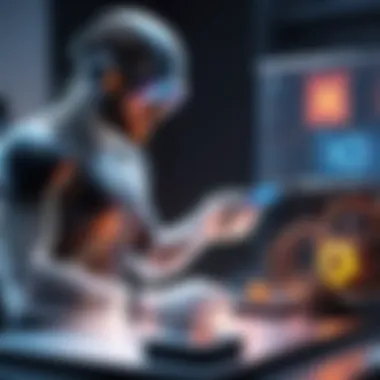Unlocking Opportunities: A Deep Dive into 3D Printing Engineer Jobs


Tech Trend Analysis
As we delve into the realm of 3D printing engineer jobs, it's crucial to analyze the current tech trends shaping this field. The advent of additive manufacturing has revolutionized traditional manufacturing processes, offering unprecedented precision and customization. This trend holds significant implications for consumers, enabling them to access personalized products and prototypes with speed and efficiency like never before. Looking ahead, the future predictions and possibilities in 3D printing engineering point towards further advancements in materials, printing speeds, and scalability, expanding the applications across various industries.
Product Reviews
In the domain of 3D printing engineer jobs, understanding the key products in this sector is essential. Examining the features and specifications of leading 3D printers unveils a spectrum of capabilities, from multi-material printing to large-scale production capacities. Performance analysis showcases the quality, reliability, and speed of these machines, informing professionals of their operational efficiency. Highlighting the pros and cons of different models provides a nuanced perspective for making informed decisions, culminating in valuable recommendations for aspiring 3D printing engineers.
How-To Guides
For individuals embarking on a career in 3D printing engineering, comprehensive how-to guides serve as invaluable resources. Introducing the fundamental concepts and technologies involved in 3D printing sets the groundwork for further exploration. Step-by-step instructions detailing the process of designing, slicing, and printing 3D models offer practical insights into the workflow of a 3D printing engineer. Tips and tricks shared by experienced professionals enhance the efficiency and efficacy of printing tasks, while troubleshooting guidelines address common challenges, empowering enthusiasts to navigate complex scenarios with confidence.
Industry Updates
Keeping abreast of recent developments in the tech industry is paramount for 3D printing engineers. Analyzing market trends provides valuable insights into the demand for additive manufacturing solutions across sectors such as aerospace, healthcare, and automotive. These developments have a significant impact on businesses and consumers, driving innovation, cost-efficiency, and sustainability. By staying informed about industry updates, professionals can strategically position themselves to leverage emerging opportunities and contribute meaningfully to the ever-evolving landscape of 3D printing engineering.
Preamble
In this article, we embark on a detailed exploration of 3D printing engineer jobs, delving into various aspects that define this dynamic field. The significance of understanding 3D printing lies in its transformative impact on modern technology landscapes, paving the way for innovative engineering solutions and manufacturing processes. By unraveling the key principles and tracing the origins and evolution of 3D printing, we aim to equip readers with a comprehensive understanding of this cutting-edge domain.
Understanding 3D Printing
Origins and Evolution
Exploring the origins and evolution of 3D printing unveils a fascinating journey from its nascent stages to its current state of technological prowess. The evolution of this innovative technology has revolutionized traditional manufacturing paradigms, offering limitless possibilities for customization and rapid prototyping. Understanding the historical trajectory helps contextualize the advancements driving contemporary 3D printing innovations, demonstrating its pivotal role in shaping the future of engineering and design.
Key Principles
Delving into the key principles governing 3D printing techniques sheds light on the foundational elements underpinning this advanced manufacturing process. From additive manufacturing concepts to intricate layering methodologies, these principles are instrumental in achieving precision and efficiency in creating intricate 3D models. By grasping these core principles, aspiring 3D printing engineers can enhance their proficiency and adaptability, driving excellence in translating digital designs into tangible objects.
Significance in Today's Tech Landscape
Impact on Industries
The impact of 3D printing on industries is multifaceted, heralding a new era of production efficiency and product customization. Industries across sectors such as automotive, healthcare, and aerospace are leveraging 3D printing technologies to streamline manufacturing processes and improve product design capabilities. The integration of additive manufacturing techniques has not only optimized production workflows but also catalyzed innovation in product development, propelling businesses towards sustainable growth and competitive advantage.
Future Potential
Exploring the future potential of 3D printing unveils a landscape brimming with opportunities for technological advancement and industrial expansion. As the capabilities of 3D printing continue to evolve, the prospect of revolutionary breakthroughs in material science, bioengineering, and sustainable manufacturing emerges on the horizon. By anticipating the future trajectory of 3D printing technology, professionals in this field can proactively position themselves to harness upcoming trends and drive innovation across diverse domains.
Skills and Qualifications


Skills and qualifications play a pivotal role in the realm of 3D printing engineer jobs. Aspiring professionals need to arm themselves with a diverse skill set and relevant qualifications to navigate this dynamic field successfully. Technical proficiency and problem-solving prowess are at the core of excelling in 3D printing engineering roles. A strong foundation in CAD software and a profound understanding of various materials are critical components that can set an individual apart in this competitive landscape.
Technical Proficiency
CAD Software
CAD software stands as a cornerstone in the toolkit of a 3D printing engineer. It enables engineers to create intricate designs with precision and accuracy, facilitating the transition from concept to tangible product seamlessly. The key characteristic of CAD software lies in its ability to render complex geometries and dimensions, offering a highly efficient platform for design iteration and validation. The unique feature of parametric modeling empowers engineers to make quick changes to designs, improving workflow efficiency. Despite its advantages in streamlining the design process, CAD software may pose a steep learning curve for beginners.
Material Knowledge
Material knowledge holds immense significance in the realm of 3D printing engineering. Understanding the properties, behaviors, and limitations of various materials is crucial for selecting the most suitable materials for specific applications. Engineers with a profound grasp of material science can optimize designs for performance, durability, and cost-effectiveness. The key characteristic of material knowledge lies in its ability to influence design decisions and material selection, directly impacting the quality and functionality of the final product. While the flexibility of material choices enhances design versatility, inadequate material knowledge may result in suboptimal outputs and potential setbacks in the production process.
Problem-Solving Skills
Analytical Thinking
Analytical thinking serves as the foundation for effective problem-solving in 3D printing engineering. Engineers adept at analyzing complex problems can deconstruct challenges, identify key variables, and devise strategic solutions to overcome obstacles. The key characteristic of analytical thinking lies in its ability to rationalize decisions based on data-driven insights, fostering a systematic approach to problem-solving. The unique feature of predictive modeling enables engineers to anticipate potential issues and implement preemptive measures, ensuring smoother project execution. However, relying solely on analytical thinking may sometimes constrain creative problem-solving approaches.
Innovative Approach
An innovative approach is a driving force behind disruptive advancements in 3D printing engineering. Engineers who embrace innovation continually seek novel solutions, challenge traditional methodologies, and push the boundaries of what is achievable within the field. The key characteristic of an innovative approach lies in its capacity to inspire unconventional thinking, spark creativity, and catalyze groundbreaking developments. The unique feature of rapid prototyping empowers engineers to iterate quickly on concepts, fostering a culture of experimentation. Nevertheless, maintaining a balance between innovation and practicality is essential to avoid unfeasible or impractical solutions.
Career Opportunities
Delving into the realm of 3D printing engineer jobs unveils a plethora of career opportunities that beckon tech enthusiasts and industry professionals alike. The arena of 3D printing engineering brims with excitement and innovation, offering individuals the chance to immerse themselves in a dynamic field poised for exponential growth. As technology continues to advance at an unprecedented pace, the demand for skilled 3D printing engineers escalates, presenting a lucrative path for those inclined towards cutting-edge solutions and creative problem-solving.
Industry Insights
Automotive Sector
The Automotive Sector stands as a pivotal player in the adoption of 3D printing technology, revolutionizing traditional manufacturing methods and streamlining production processes. With a keen focus on achieving efficiency and customization, the Automotive Sector harnesses the power of 3D printing to craft intricate components and prototypes with unparalleled accuracy. The agility offered by additive manufacturing in this sector enables rapid prototyping and iteration, leading to faster product development cycles and enhanced design capabilities. However, challenges such as material durability and regulatory compliance persist, necessitating continuous innovation and refinement to fully leverage the benefits of 3D printing.
Healthcare Industry
Within the Healthcare Industry, 3D printing emerges as a groundbreaking tool reshaping patient care and medical interventions. By facilitating the creation of personalized implants, prosthetics, and anatomical models, 3D printing enables tailored solutions for complex healthcare needs, significantly improving treatment outcomes and patient experiences. The intersection of technology and healthcare embodies a paradigm shift towards patient-centric care, where precision and customization play pivotal roles in enhancing medical practices. Despite its transformative impact, considerations regarding material biocompatibility and manufacturing standards underscore the importance of stringent quality control measures in 3D printing applications within the healthcare domain.
Aerospace Field
The Aerospace Field epitomizes innovation and precision, making it an ideal fit for the implementation of 3D printing technology. Leveraging additive manufacturing, aerospace engineers can design intricate components with reduced weight and increased structural integrity, thus optimizing fuel efficiency and overall performance metrics. The ability to fabricate complex geometries and optimize part consolidation through 3D printing fosters agile development cycles and cost-effective solutions in the aerospace sector. Yet, challenges related to material testing, certification protocols, and scalability remain critical considerations in integrating 3D printing within the aerospace industry.
Emerging Roles
Additive Manufacturing Specialist


The role of an Additive Manufacturing Specialist embodies expertise in leveraging 3D printing technology to unlock new possibilities in product development and industrial applications. With a focus on material selection, process optimization, and quality assurance, these specialists drive innovation and efficiency within manufacturing environments. Their adeptness at integrating additive manufacturing into existing workflows and enhancing production capabilities underscores their significance in navigating the complexities of implementation and scalability. However, the continuous evolution of 3D printing techniques demands a proactive approach to staying abreast of industry advancements and best practices.
Prototyping Engineer
The Prototyping Engineer plays a pivotal role in translating conceptual designs into tangible prototypes through the utilization of 3D printing techniques. By leveraging rapid prototyping capabilities, these engineers enable iterative design processes, rapid validation of ideas, and seamless collaboration between design and production teams. Their profound understanding of materials, design considerations, and manufacturing constraints empowers them to deliver functional prototypes that embody design intent and performance requirements. Despite the efficiency and flexibility offered by 3D printing in prototyping, challenges related to post-processing, validation testing, and scalability necessitate a comprehensive approach to prototyping engineering practices.
Professional Development
Professional development is a critical aspect in the realm of 3D printing engineer jobs. It plays a pivotal role in enhancing skills, knowledge, and capabilities necessary to excel in this fast-evolving field. Continuous learning and upskilling are vital to staying abreast of the latest technological advancements and industry trends. Embracing professional development opportunities can lead to career growth, job satisfaction, and increased employability. It enables individuals to enhance their expertise in areas such as CAD software design, materials science, and additive manufacturing techniques. Engaging in professional development fosters a mindset of lifelong learning and adaptability, crucial in a competitive job market.
Certifications and Courses
Certified SolidWorks Associate
Certified SolidWorks Associate certification holds significant value for aspiring 3D printing engineers. It validates proficiency in utilizing SolidWorks software for product design and development. This certification showcases expertise in creating 3D models, assemblies, and drawings using SolidWorks tools. The Certified SolidWorks Associate designation signifies a strong foundation in CAD design principles and practices. It is a sought-after qualification by employers seeking candidates with hands-on experience in parametric modeling and simulation. While obtaining this certification demands dedication and effort, the benefits include improved job prospects, professional credibility, and enhanced design skills.
Additive Manufacturing Fundamentals
Additive Manufacturing Fundamentals course offers a comprehensive understanding of the core principles and techniques in 3D printing. This course covers key concepts like material selection, layer-by-layer printing processes, and post-processing methods. Participants gain insights into different additive manufacturing technologies, including Fused Deposition Modeling (FDM) and Stereolithography (SLA). Understanding the fundamentals of additive manufacturing is crucial for optimizing print quality, reducing production costs, and exploring innovative design possibilities. By completing this course, individuals can broaden their expertise in additive manufacturing, which is integral to excelling in 3D printing engineer roles.
Networking Opportunities
Industry Conferences
Participating in industry conferences is a valuable networking opportunity for 3D printing professionals. These events bring together experts, thought leaders, and enthusiasts to discuss the latest trends and advancements in the additive manufacturing sector. Industry conferences offer a platform to showcase innovations, share knowledge, and forge strategic partnerships. Attending conferences allows individuals to expand their professional network, gain industry insights, and stay updated on emerging technologies. The unique feature of industry conferences lies in the diverse range of topics covered, including 3D printing applications in aerospace, healthcare, and automotive industries.
Online Communities
Engaging in online communities is a convenient way for 3D printing engineers to connect with peers, exchange ideas, and seek advice. Online communities provide a platform for sharing experiences, troubleshooting technical issues, and obtaining feedback on design projects. The key characteristic of online communities is the collaborative environment that fosters creativity and knowledge sharing among members. By participating in online forums, individuals can stay informed about industry trends, tools, and best practices. However, it is essential to exercise caution regarding the accuracy of information shared and maintain professional conduct in online interactions.
Salary Trends
In the realm of 3D printing engineer jobs, understanding Salary Trends is of paramount importance. It serves as a key indicator of the financial landscape within this dynamic field, offering insights into the remuneration packages and value placed on the expertise of 3D printing engineers. By delving into Salary Trends, one can gain a comprehensive view of the market demand for these professionals and the monetary recognition they receive for their contributions to the technological landscape.
Factors Influencing Salaries
Experience Level
When dissecting the Factors Influencing Salaries, Experience Level stands out as a critical determinant. The level of experience a 3D printing engineer possesses plays a pivotal role in shaping their earning potential. Those with extensive experience often command higher salaries due to their seasoned expertise and demonstrated track record of success. This factor propels experienced engineers towards lucrative compensation packages, reflecting the value attached to their wealth of knowledge and practical skills in navigating the complex nuances of 3D printing technologies.
Industry Sector


Another vital facet in understanding Salary Trends revolves around the Industry Sector in which a 3D printing engineer operates. Different sectors offer varying salary structures based on the demand for 3D printing expertise and the financial health of the industry. For instance, engineers working in burgeoning sectors like healthcare or aerospace may receive higher salaries due to the specialized nature of their work and the critical role 3D printing plays in advancing innovations within these industries. Conversely, engineers in less financially robust sectors may encounter more modest salary offerings, reflecting the industry's economic constraints.
Average Salary Range
Entry-Level Positions
Examining the Average Salary Range, one encounters the nuanced discussion of Entry-Level Positions. Entry-level engineers, typically fresh graduates or professionals with limited experience, often begin their careers at the lower end of the salary spectrum. Despite this, entry-level positions provide aspiring engineers with valuable hands-on experience, allowing them to refine their skills and gradually climb the salary ladder as they accumulate expertise and demonstrate their capabilities. While entry-level roles may initially offer lower compensation, the potential for career growth and skill development presents an attractive prospect for those embarking on their 3D printing engineering journey.
Senior Engineer Roles
Conversely, Senior Engineer Roles represent the pinnacle of the salary spectrum within the 3D printing engineering domain. Seasoned professionals occupying senior roles bring a wealth of experience and strategic prowess to the table, warranting higher salary brackets commensurate with their leadership responsibilities and specialized skill set. In senior positions, engineers not only command competitive salaries but also enjoy perks such as decision-making authority, mentorship opportunities, and the chance to shape the strategic direction of 3D printing projects within their organizations. The allure of senior roles lies not only in the financial rewards but also in the professional prestige and impact these positions offer within the intricate tapestry of 3D printing engineering.
Job Search Strategies
In the realm of 3D printing engineer jobs, mastering effective job search strategies is paramount. This section delves deep into the intricacies of navigating the job market in this dynamic field. Job search strategies encompass a spectrum of activities, from leveraging online platforms to tapping into professional associations. By honing these strategies, aspiring 3D printing engineers can enhance their visibility to potential employers and secure rewarding opportunities in the industry.
Online Platforms
When it comes to online professional networking, LinkedIn stands out as a linchpin for job seekers in the tech realm. Its immense user base and focus on creating meaningful connections make it a go-to platform for professionals worldwide. LinkedIn's robust features, such as job postings, company insights, and networking groups, offer invaluable resources for individuals seeking to advance their careers. Despite its advantages, careful curation of profiles and active engagement are crucial to stand out in the competitive landscape.
Indeed
Indeed serves as a comprehensive job search engine that collates listings from various sources, simplifying the process for job seekers. Its user-friendly interface and vast job database make it a popular choice for individuals exploring new career avenues, including those in 3D printing engineering. Additionally, Indeed's job alert functionalities and easy application processes streamline the job search experience, increasing the efficiency of job seekers. However, the platform's sheer volume of listings necessitates discernment and proper filtering to identify suitable opportunities effectively.
Professional Associations
Society of Manufacturing Engineers
The Society of Manufacturing Engineers (SME) plays a pivotal role in fostering professional development and networking opportunities for individuals in the manufacturing sector, including 3D printing engineers. By joining SME, professionals can access exclusive industry insights, training programs, and networking events, amplifying their chances of career growth and advancement. SME's commitment to driving innovation and excellence in manufacturing makes it a valuable resource for individuals keen on expanding their horizons within the industry.
Additive Manufacturing Users Group
As a dedicated community for additive manufacturing enthusiasts, the Additive Manufacturing Users Group (AMUG) provides a platform for knowledge exchange and collaboration among industry professionals. Membership in AMUG offers access to conferences, workshops, and industry forums focused on the latest trends and advancements in additive manufacturing. Engaging with AMUG enables 3D printing engineers to stay abreast of industry developments and forge connections with like-minded professionals, enriching their professional journey.
Finale
In the realm of 3D Printing Engineer Jobs, the Conclusion section serves as a pivotal point for individuals seeking a nuanced understanding of the intricate facets of this dynamic field. It consolidates the essential insights garnered throughout this comprehensive guide, epitomizing the convergence of skills, opportunities, and challenges that define the landscape of a 3D printing engineer. Through a thorough reflection on the discussed topics, readers can extrapolate the practical implications and strategic approaches crucial for navigating the ever-evolving domain of 3D printing engineering.
Looking Ahead
Future Growth Prospects
Delving into the Future Growth Prospects within the 3D printing engineering sphere sheds light on the trajectory and potential advancements awaiting professionals in this field. By dissecting the specific trajectories and emerging trends, individuals can discern the transformative impacts of technological innovations and market demands within the realm of 3D printing. Understanding the pivotal role that Future Growth Prospects play accentuates the importance of embracing continual learning, adaptation, and foresight to capitalize on the evolving landscape of 3D printing engineering, fostering resilience and agility crucial for sustained relevance and impact.
Continuous Learning
Continuous Learning stands as a cornerstone in the domain of 3D Printing Engineer Jobs, underscoring the philosophy of perpetual development and skill enhancement. Embracing Continuous Learning equips professionals with the adaptive capacity to navigate through the myriad challenges and opportunities presented by the dynamic nature of 3D printing technology. By immersing in a culture of continuous growth and education, individuals can fortify their competencies, embrace innovation, and cultivate a mindset of perpetual improvement essential for excelling in the multifaceted realm of 3D printing engineering. This strategic commitment to Continuous Learning not only fosters personal and professional growth but also ensures a sustainable trajectory towards success and leadership within the vibrant domain of 3D printing engineering.



